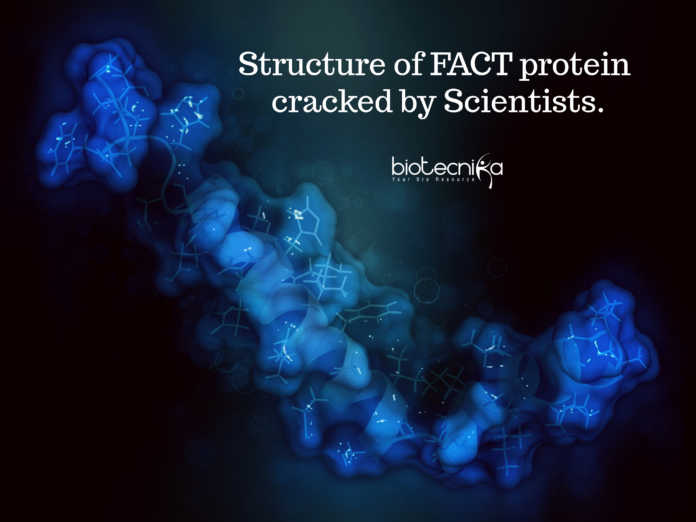DNA’s chaperone: FACT Protein, Its Structure Finally Decoded.
Scientists cracked the structure of FACT protein, the chaperone in the functioning of DNA.
Just like students at a high school dance, the proteins that package DNA require a chaperone. We have known this for a long time now, but the exact structure of this guardian and its behavior has been unknown until now.
The University of Colorado Boulder scientists has now decoded the mysterious structure of the ‘Facilitates Chromatin Transcription’ (or FACT) protein. The FACT protein is partly responsible for ensuring there are no improper interactions and everything goes on smoothly in DNA when it sheds temporarily and the guardian histones or proteins are replaced.
The study’s findings are a result of five years project at CU Boulder. It is out in the Nature journal. The findings in this research are of great value in not just understanding the gene transcription and genome but also for understanding cancer and in developing anti-cancer drugs.
One of the study’s lead authors and a research associate at CU Boulder, Yang Liu said, “This is not the end, it’s just the beginning for this protein.”
The FACT protein was discovered in 1998 and since then
, it has been of great interest to those studying DNA, mainly because of the various possibilities this protein has. Even though there have been decades of efforts in understanding the proteins, the main question of the working of the protein has remained unanswered. FACT protein is an essential type of histone chaperone.During the destructions and reconstruction of nucleosomes (which is the structural unit responsible for packing and organizing DNA), the guardian proteins escort other proteins. This happens during the transcription of a gene, i.e., the step where the DNA is copied into RNA, during replication of DNA, i.e., when the whole genome is replicated and during DNA damage repair which is important in preventing diseases like cancer.
But, not knowing the exact structure of the protein, researchers have been wondering how does this protein maintains and also destroys. In this research, there are answers for both.
Keda Zhou, the other lead author for the paper and a research associate at CU Boulder says, “People have tried for a long time to find the mechanism behind how the FACT protein helps in transcription. Researchers have been working on various aspects of this protein and we are the ones to identify first, so we’re really happy about this.”
This team of scientists along with a lab from New York and another lab from Texas has finally decoded this mystery by the isolation of the FACT protein with a lot of ingenuity, tenacity and hard work. They managed to map it out and discover its action of both the destruction and maintenance of the nucleosome.
It was found that this FACT protein resembles the fork and saddle of a unicycle, consisting of many domains that straddle the nucleosome wheel of the unicycle. Until then, scientists only saw one domain at once which caused contradictory results and confusion.
Still, not one of those varied findings appeared to be wrong.
Everything was put together by Zhou and Liu’s work. The senior author of this study and the endowed chair of biochemistry at CU Boulder, a Howard Hughes Medical Institute (HHMI) Investigator said, “It looked like everyone was correct and that’s cool.”
For both the Luger’s lab and the broader medical community, this protein’s discovery is just the start.
A modern cryo-electron microscope was purchased earlier this year by CU Boulder with aid of matching funds from HHMI, which allowed researchers to see structures of biomolecules in ultra-high-resolution. Using this microscope, Luger wants to find more about the FACT protein.
Luger said, “Other protein’s action can be caught by using these modern technologies. It is like there could be a movie made with a detailed step by step process, where we can watch every part’s action during this process. Technology has made this possible!”
The result of something wrong in the DNA replication or gene transcription or the repair process is what leads to cancer, and hence, this research can shed light in these areas leading to cancer treatment research.
Zhou says, “This is the beginning though there are many unknowns”






























